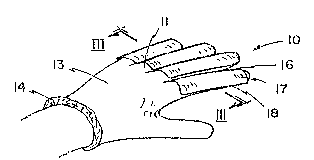Some of the information on this Web page has been provided by external sources. The Government of Canada is not responsible for the accuracy, reliability or currency of the information supplied by external sources. Users wishing to rely upon this information should consult directly with the source of the information. Content provided by external sources is not subject to official languages, privacy and accessibility requirements.
Any discrepancies in the text and image of the Claims and Abstract are due to differing posting times. Text of the Claims and Abstract are posted:
| (12) Patent: | (11) CA 1322821 |
|---|---|
| (21) Application Number: | 1322821 |
| (54) English Title: | FINNED PHALANGEAL DEVICE |
| (54) French Title: | APPAREIL PHALANGIEN A AILETTES |
| Status: | Expired and beyond the Period of Reversal |
| (51) International Patent Classification (IPC): |
|
|---|---|
| (72) Inventors : |
|
| (73) Owners : |
|
| (71) Applicants : |
|
| (74) Agent: | MITCHES & CO. |
| (74) Associate agent: | |
| (45) Issued: | 1993-10-12 |
| (22) Filed Date: | 1989-02-21 |
| Availability of licence: | Yes |
| Dedicated to the Public: | N/A |
| (25) Language of filing: | English |
| Patent Cooperation Treaty (PCT): | No |
|---|
| (30) Application Priority Data: | None |
|---|
- 7 -
TITLE
FINNED PHALANGEAL DEVICE
APPLICANT
NIAGARA PROSTHETICS AND ORTHOTICS CORP.
INVENTOR
Robert GABOURIE C. P.
ABSTRACT
A finned phalangeal device includes a plurality of
spacially disposed, phalanges. On each phalange, a
longitudinal flexible fin element is attached on the back side
while allowing the longitudinal margins of each flexible film
element to extend normally toward a like element on an
adjacent phalange. When the device is moved in one direction
through a fluid the flexible fin elements feather against the
phalange and allow the fluid to pass between adjacent
phalanges with relatively little resistance. When the device
is moved in the opposite direction the flexible fin elements
open to adjacently overlay each other and hence to provide a
fluid seal inhibiting fluid flow between adjacent phalanges.
In one embodiment the phalanges are integral members of a
glove and specifically are finger encircling elements thereof
while in another embodiment each phalange is a rigid
prosthesis element simulating those fingers.
Note: Claims are shown in the official language in which they were submitted.
Note: Descriptions are shown in the official language in which they were submitted.

2024-08-01:As part of the Next Generation Patents (NGP) transition, the Canadian Patents Database (CPD) now contains a more detailed Event History, which replicates the Event Log of our new back-office solution.
Please note that "Inactive:" events refers to events no longer in use in our new back-office solution.
For a clearer understanding of the status of the application/patent presented on this page, the site Disclaimer , as well as the definitions for Patent , Event History , Maintenance Fee and Payment History should be consulted.
| Description | Date |
|---|---|
| Inactive: IPC from MCD | 2006-03-11 |
| Inactive: IPC from MCD | 2006-03-11 |
| Inactive: Adhoc Request Documented | 1996-10-12 |
| Time Limit for Reversal Expired | 1996-04-14 |
| Letter Sent | 1995-10-12 |
| Grant by Issuance | 1993-10-12 |
There is no abandonment history.
Note: Records showing the ownership history in alphabetical order.
| Current Owners on Record |
|---|
| NIAGARA PROSTHETICS & ORTHOTICS CORP. |
| Past Owners on Record |
|---|
| ROBERT GABOURIE |